Pushing Your Comfort Zone
A little planning goes a long way in injury prevention
Bob Kaehler

Rowing has its share of overuse injuries. Factors that increase your risk of injury include: changing training volume or intensity too quickly, and allowing too little recovery time during and between during training sessions. Other contributing factors include improper technique, poor flexibility and strength, and inadequate nutrition. Careful planning and learning to listen to your body’s signals are essential to minimizing the impact of overuse injuries.
Training outside of your comfort zone
Experiencing pain is a necessary evil of endurance training, especially when you’re training outside of your comfort zone -- your usual training approach that doesn’t exceed or challenge your physiological limitations. Pushing yourself out of your comfort zone is critical for developing your physical and mental capacity, as well as improving your lactate buffering capacity or VO2 max.
Often, when pain does show up, the brain goes into survival mode and tells you to keep going -- that the pain will go away. While some athletes will immediately stop their activities and get themselves checked out, others will train through the initial signs of pain and enter an uncomfortable zone. However, when pain is long-lasting, we have to use it as a “coach” that is telling you something is wrong. When we ignore the initial symptoms and train into an uncomfortable zone, we place ourselves at risk of sustaining injuries of greater magnitude.
Training volume and injury risk
Numerous studies conducted on running athletes have examined the relationship between mileage and injury rate. Once running mileage exceeds about 20-25 miles per week, studies indicate that the rate of injury increases significantly. While I’m not aware of any studies focused specifically on the relationship between rowing volume and training-related injuries, I have made similar observations based on my own coaching and conditioning experience.
Masters and junior-level rowers who exceed about four to five hours of rowing per week seem to sustain a noticeable jump in their rate of injuries. Collegiate and high-level club rowers seem to be able to handle about twice that amount (eight-to-10 hours per week) of training before sustaining a similar increase in training-related injuries. Large changes in training volume in short periods of time also trigger increases in injury. This often explains why coaches notice increases in injury rates when high school rowers begin their collegiate careers, or when college rowers start training with the National Team.
Training transitions: Understand expectations and be prepared
When you’re transitioning to the next level of your endurance sport, understand what will be expected of you and plan ahead. What will be your new normal weekly training volume and intensity? This information will help you determine how to increase your conditioning in a controlled and safe manner. Preparing your body to accept new training loads and training volume is a critical component to reducing your risk of training-related injuries. The general consensus for increasing exercise volume and intensity (I also use this guideline in my coaching and conditioning) is to increase training volume by no more than 10% per week. In my practice I do not increase training intensity by more than 10% per week, and often times it is less than 10%.
In rowing, training volume is easy to measure, and intensity can be measured by using watts on the ergometer, or by measuring speed in the boat. The same guidelines apply to increases in rating -- no more than a 10% increase per week. Similarly, for running and cycling, we can use speed as the best measurement to control intensity, and mileage for volume. For cycling, we can use wattage and speed.
Technique can also break down from fatigue when program volume and intensity change too quickly, or when deficits in strength and flexibility do not allow the athlete to get into proper sport specific positions for their sport. Both of these issues can lead to overuse training injuries. Building yourself up carefully and gradually, with consistent and small increases in training volume and intensity is the safest and most effective way to accept new loads and stresses on the body, and minimize your risk of injury.
Muscle and flexibility imbalances
Musculoskeletal pain is a common byproduct of endurance training, especially as intensity increases or if strength training is used. Flexibility and strength requirements vary amongst endurance sports and when not properly addressed, can be a recipe for disaster when training volume and intensity increase, and can lead to training-related pain. Imbalances in flexibility and strength can actually get worse as an athlete shifts from a low volume and low intensity training program (less than five hours/per week), to a higher volume and higher intensity training program.
Paying attention to these imbalances is important for all levels, but is often neglected when there are no signs. When musculoskeletal training pain does arise and doesn’t go away quickly (two or three days) or gets worse, stop your program and get checked out by a sports medicine professional. This is a clear example of when not to train out of your comfort zone, as it often leads to a more significant injury with a longer recovery time.
Many endurance athletes do not realize how close they are to sustaining training-related injuries and continue to train in their comfort zone. When you have no training-related pain, it is easy to skip the detail work -- proper stretching and strengthening – and just keep doing what you’re doing. Manipulating training volume and intensity must be done slowly and carefully at all levels of experience with a carefully laid-out plan. In addition, both coaches and athletes need to be aware of individual flexibility and strength-related issues that can impact their specific endurance sports. Working together with a carefully laid-out plan will not only help the athlete improve their performance, but also reduce the odds of getting training-related injuries.
If you enjoy and rely on row2k, we need your help to be able to keep doing all this. Though row2k sometimes looks like a big, outside-funded operation, it mainly runs on enthusiasm and grit. Help us keep it coming, thank you! Learn more.
Comments | Log in to comment |
- Bont Rowing
- Calm Waters Rowing
- Concept 2
- Craftsbury Sculling
- The Crew Classic
- CrewLAB
- Croker
- Durham Boat Co.
- Empacher
- Faster Masters
- Filippi
- Fluidesign
- h2row.net
- HUDSON
- Live2Row Studios
- Nielsen-Kellerman
- Oak Ridge RA
- Peinert Boat Works
- Pocock Racing Shells
- Race1 USA
- RowKraft
- Rubini Jewelers
- Vespoli USA
- WinTech Racing
- Bont Rowing
- Calm Waters Rowing
- Concept 2
- Craftsbury Sculling
- The Crew Classic
- CrewLAB
- Croker
- Durham Boat Co.
- Empacher
- Faster Masters
- Filippi
- Fluidesign
- h2row.net
- HUDSON
- Live2Row Studios
- Nielsen-Kellerman
- Oak Ridge RA
- Peinert Boat Works
- Pocock Racing Shells
- Race1 USA
- RowKraft
- Rubini Jewelers
- Vespoli USA
- WinTech Racing
























07/14/2011 4:37:30 PM